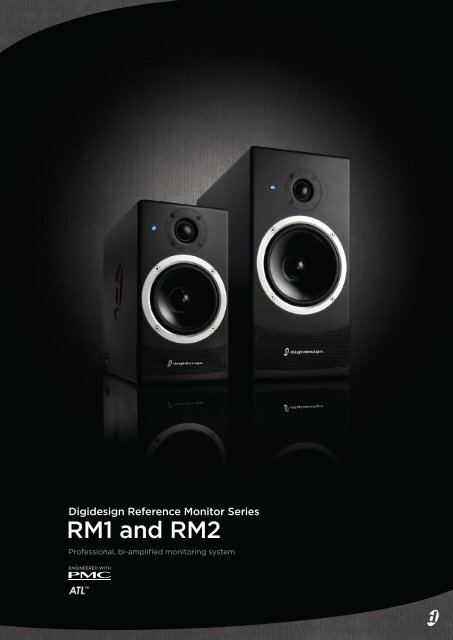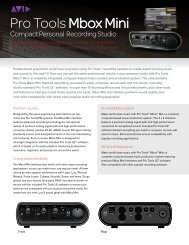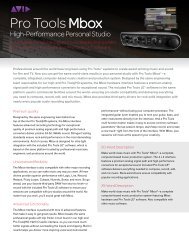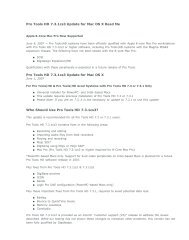RM1 and RM2 - Giant Electronics
RM1 and RM2 - Giant Electronics
RM1 and RM2 - Giant Electronics
Create successful ePaper yourself
Turn your PDF publications into a flip-book with our unique Google optimized e-Paper software.
Digidesign Reference Monitor Series<br />
<strong>RM1</strong> <strong>and</strong> <strong>RM2</strong><br />
Professional, bi-amplified monitoring system
<strong>RM1</strong> <strong>and</strong> <strong>RM2</strong> Features<br />
• Professional, bi-amplified monitoring system<br />
• Analog <strong>and</strong> digital inputs (up to 24-bit/96 kHz)<br />
• Audiophile-grade, analog-controlled Class D<br />
amplifiers with high-quality linear power<br />
supply units<br />
• Advanced Transmission Line (ATL) technology<br />
provides high SPL <strong>and</strong> superior bass extension<br />
• Unrivaled tonal accuracy, clarity, <strong>and</strong> dynamic<br />
range with exceptionally low distortion<br />
• Powerful onboard DSP engine provides:<br />
- Extremely accurate digital crossover for<br />
pristine imaging<br />
- Bass Port Emulation mode to emulate tonal<br />
characteristics of ported bass reflex speakers<br />
- Precise gain trim, low- <strong>and</strong> high-frequency<br />
adjustment, <strong>and</strong> speaker placement settings<br />
• Low jitter analog-to-digital converter (ADC)<br />
with low-noise clock oscillator<br />
• Sound dispersion design maintains accurate<br />
frequency response even in off-axis listening<br />
positions<br />
<strong>RM1</strong> <strong>and</strong> <strong>RM2</strong> provide various inputs<br />
<strong>and</strong> controls on the back—here’s a look<br />
at these on <strong>RM2</strong> (<strong>RM1</strong> is identical).<br />
Power switch<br />
HF control allows you to set the<br />
high-frequency response (from<br />
-4 dB to +3 dB in 0.5 dB increments)<br />
LF control allows you to set the<br />
low-frequency response (from<br />
-4 dB to +3 dB in 0.5 dB steps)<br />
Channel Assign allows you to<br />
select which AES digital input<br />
channel (left or right) to produce<br />
Gain Trim encoder enables you<br />
to set the input sensitivity (from<br />
0 dB to -15 dB)<br />
Bass Port Emulation switch<br />
AES 3 digital input (XLR)—accepts<br />
44.1, 48, 88.2, <strong>and</strong> 96 kHz sample rates<br />
Balanced analog input (XLR)<br />
AES digital input (RJ-45)<br />
AES digital THRU connector (RJ-45)<br />
High-Definition Sound—Revealed<br />
Digidesign revolutionized the professional<br />
recording industry with its Pro Tools ® digital<br />
audio workstation. And for over 20 years,<br />
Digidesign has developed groundbreaking<br />
technologies <strong>and</strong> tools that have energized<br />
audio professionals <strong>and</strong> garnered hundreds of<br />
industry accolades, including Grammy ® <strong>and</strong><br />
Oscar ® awards for technical achievement.<br />
But above all, Digidesign’s goal is to continuously<br />
innovate <strong>and</strong> deliver products that sustain the<br />
highest audio quality possible. Its recording<br />
<strong>and</strong> mixing systems boast unrivalled sound<br />
quality with 24-bit/192 kHz audio resolution.<br />
Its Pro Tools architecture features a true, fixedpoint,<br />
48-bit mixer that yields nearly 300 dB<br />
of dynamic range. And many of its high-quality<br />
plug-ins provide double-precision processing<br />
for the ultimate in dynamic range <strong>and</strong> headroom.<br />
To reinforce its objective for pure, highdefinition<br />
audio, Digidesign makes its<br />
foray into the loud-speaker market with<br />
the Digidesign ® Reference Monitor Series<br />
(RMS), offering two professional near-field<br />
monitors—the <strong>RM1</strong> <strong>and</strong> <strong>RM2</strong>—co-developed<br />
with PMC, the Professional Monitor Company.<br />
The <strong>RM1</strong> <strong>and</strong> <strong>RM2</strong> unite Digidesign’s deep<br />
expertise in digital audio with PMC’s legacy<br />
of fine, h<strong>and</strong>crafted, cutting-edge design<br />
<strong>and</strong> meticulous manufacturing.<br />
Engineered with PMC–The Professional<br />
Monitor Company<br />
Based in the United Kingdom, PMC is a<br />
world-leading manufacturer of professional<br />
monitor <strong>and</strong> audiophile speaker systems.<br />
Its Advanced Transmission Line (ATL)<br />
technology delivers high-resolution, wideb<strong>and</strong>width<br />
signal response <strong>and</strong> accurate<br />
low-frequency response without distortion.<br />
Partnering with PMC was a logical choice for<br />
Digidesign as both companies have spent their<br />
entire histories developing <strong>and</strong> advancing<br />
pioneering audio technologies that empower<br />
audio professionals to create the best-sounding<br />
audio possible. Together Digidesign <strong>and</strong> PMC<br />
strive to redefine near-field monitoring by<br />
providing the best sounding, incredibly accurate<br />
audio reference to help engineers create better<br />
mixes that ultimately translate well to any<br />
speaker system.<br />
With the Digidesign Reference Monitor Series,<br />
Digidesign <strong>and</strong> PMC have created a monitoring<br />
system that delivers total clarity across the<br />
frequency spectrum, enabling you to truly hear<br />
an impeccably accurate representation of your<br />
mix at any stage.<br />
<strong>RM1</strong> <strong>and</strong> <strong>RM2</strong>: Redefining Near-Field<br />
Monitoring<br />
The Digidesign <strong>RM1</strong> <strong>and</strong> <strong>RM2</strong> monitoring<br />
systems utilize PMC’s ATL technology to<br />
deliver high-definition audio with unrivaled,<br />
accurate bass response. Both systems<br />
feature a revolutionary, onboard digital signal<br />
processing (DSP) engine that manages a<br />
variety of tasks, including the complex digital<br />
crossover <strong>and</strong> Bass Port Emulation mode,<br />
which emulates the frequency characteristics<br />
of a bass reflex speaker, allowing you to hear<br />
how your mix “translates” to a ported speaker.<br />
Both monitors are designed with proprietary<br />
drivers, digital electronics, power amp, <strong>and</strong><br />
cabinet engineering to provide unrivalled tonal<br />
accuracy, exceptionally low distortion, stunning<br />
clarity, <strong>and</strong> incredible dynamic range. And<br />
their wide sound dispersion ensures accurate<br />
frequency response even if you’re listening<br />
in an off-axis position.<br />
The compact <strong>RM1</strong> boasts performance<br />
comparable to much larger monitors, <strong>and</strong><br />
is the ideal monitoring system for project<br />
studios, editing suites, home studios, <strong>and</strong><br />
mobile production vehicles. The larger <strong>RM2</strong><br />
features a relatively small footprint compared<br />
to the competition, but is big on power <strong>and</strong><br />
sound quality, making it ideal for recording<br />
studios, mixing suites, post production facilities,<br />
broadcast installations, <strong>and</strong> other rooms that<br />
require a higher sound pressure level (SPL)<br />
<strong>and</strong> even lower bass extension.<br />
Advanced Transmission Line (ATL)<br />
Technology<br />
PMC’s ATL technology has taken loudspeaker<br />
design to new levels, combining sophisticated<br />
cabinet engineering, proprietary drive unit
1-inch soft dome, ferrofluid-cooled<br />
High Frequency driver<br />
<strong>RM1</strong><br />
5-1/2-inch Low Frequency driver<br />
optimized for the ATL design<br />
Independent, analog-controlled,<br />
class D amplifier for each driver<br />
<strong>RM2</strong><br />
6-3/4-inch Low Frequency driver<br />
optimized for the ATL design<br />
<strong>and</strong> crossover components, <strong>and</strong> patented<br />
absorption materials to deliver enormous<br />
benefits over sealed <strong>and</strong> ported speaker<br />
model designs. It’s what enables Digidesign<br />
RMS monitors to deliver improved audio<br />
resolution with a higher sound pressure level,<br />
reduced distortion, even frequency response,<br />
<strong>and</strong> deeper, more defined bass frequencies.<br />
Because of ATL technology, the <strong>RM1</strong> <strong>and</strong><br />
<strong>RM2</strong> monitors can produce higher volumes<br />
<strong>and</strong> lower bass extension than other speaker<br />
designs of similar sizes—even if identical<br />
or larger drivers are used. The frequency<br />
response also remains consistent regardless<br />
of how high or low you adjust the volume.<br />
That means you don’t need to crank the<br />
volume to achieve maximum bass response.<br />
Onboard DSP Engine<br />
Both monitors feature a 48-bit, fixed-point<br />
DSP engine that manages various tasks,<br />
including the monitors’ complex frequency<br />
crossover, speaker positioning EQ settings,<br />
trim level, <strong>and</strong> Bass Port Emulation setting.<br />
The two-way, DSP-based digital crossover<br />
features revolutionary steep <strong>and</strong> pure filter<br />
designs for the cleanest crossover—with<br />
virtually zero phase shift—so that the signal<br />
delivered to the drivers is distortion- <strong>and</strong><br />
interference-free. The crossover also allows<br />
for precision optimization for the best<br />
possible match between the two drivers’<br />
responses <strong>and</strong> their roll-off rates. This<br />
provides seamless integration between<br />
the High Frequency <strong>and</strong> Low Frequency<br />
drivers, <strong>and</strong> superb phase response over<br />
a wider listening window.<br />
Bass Port Emulation<br />
<strong>RM1</strong> <strong>and</strong> <strong>RM2</strong> feature a Bass Port Emulation<br />
mode that enables the monitors to emulate<br />
the tonal characteristics of ported bass reflex<br />
speakers. This allows you to switch from hearing<br />
your mix as it truly sounds to hearing how<br />
it would sound on typical ported speakers,<br />
enabling you to compensate for the coloration<br />
characteristics of these types of speakers in<br />
your mix.<br />
When switched to the On position, the DSP<br />
manipulates the frequency response to mimic<br />
the exaggerated bass response of a ported<br />
speaker. When switched Off, the bass response<br />
is accurate <strong>and</strong> free from coloration.<br />
Analog-Controlled, Class D Power Amplifiers<br />
<strong>RM1</strong> <strong>and</strong> <strong>RM2</strong> both feature analog-controlled<br />
Class D amplifiers that combine all of the<br />
efficiency <strong>and</strong> size advantages of digital<br />
amplifiers with the precision, control, <strong>and</strong><br />
sound quality of audiophile linear amplifiers.<br />
The power amplifier section within each<br />
speaker is 92% efficient in comparison with<br />
a linear Class A amplifier, which generally has<br />
around a 50% efficiency. This means that with<br />
Digidesign RMS monitors, more of the power<br />
from the mains is used to power the drivers<br />
rather than produce superfluous heat—<strong>and</strong><br />
they’re cheaper <strong>and</strong> greener to run than a<br />
st<strong>and</strong>ard Class A- or B-style amplifier.<br />
While typical Class D amplifier designs have<br />
a load-dependant frequency response, the<br />
amplifiers in Digidesign RMS monitors feature<br />
a single feedback loop, which senses the<br />
loudspeaker voltage directly. This provides<br />
extremely accurate amplifier frequency response<br />
regardless of the reactive load presented by the<br />
drivers, enabling the monitors to deliver higher<br />
fidelity with lower distortion. And because<br />
of their unique analog control, the monitors<br />
produce a flatter frequency response no matter<br />
what the load of the driver.<br />
High-Quality Linear Power Supply<br />
Digidesign RMS monitors employ a high-quality,<br />
linear power supply (instead of a noisy switchmode<br />
design), which provides two times the<br />
peak current headroom <strong>and</strong> the best noise<br />
isolation between the audio circuitry <strong>and</strong> mains<br />
supply. Typical switch-mode power supplies are<br />
prone to producing noise <strong>and</strong> radio frequency<br />
interference (RFI), which will not only have a<br />
detrimental effect on the amplifier, but also on<br />
other sensitive equipment connected to the<br />
same power supply or in close proximity.
Digidesign RMS Specifications<br />
General<br />
Frequency Response<br />
Peak SPL at 1 meter<br />
Effective Line Length<br />
Drive Units: Low Frequency<br />
Drive Units: High Frequency<br />
Crossover Frequency<br />
HF Adjustment<br />
LF Adjustment<br />
Input Connectors<br />
Analog<br />
Digital (AES/EBU)<br />
Input Impedance<br />
Sensitivity<br />
Input Level for Full-Scale Output<br />
Gain Trim<br />
Analog to Digital Specifications<br />
Maximum Input Level<br />
Signal to Noise Ratio<br />
THN + Noise<br />
Conversion Rate<br />
Digital to Analog Specifications<br />
Output Voltage<br />
Signal to Noise Ratio<br />
THD + Noise<br />
Power Amplifier<br />
Output Power<br />
THD + Noise<br />
Signal to Noise Ratio<br />
Frequency Response<br />
Efficiency<br />
Size / Weight / Finish<br />
Dimensions<br />
Weight<br />
Finish<br />
<strong>RM1</strong><br />
<strong>RM2</strong><br />
50 Hz - 25 kHz 40 Hz - 25 kHz<br />
111 dB 113 dB<br />
5.5-inch (140 mm) doped<br />
cone with cast alloy chassis<br />
4.9 feet (1.5 meters)<br />
6.7-inch (170 mm) doped<br />
cone with cast alloy chassis<br />
1-inch (27 mm) fabric soft dome with ferrofluid cooling<br />
3 kHz<br />
-4 dB to +3 dB in 0.5 dB steps; corner frequency 1 kHz<br />
-4 dB to +3 dB in 0.5 dB steps; 4 dB to +3 dB in 0.5 dB steps;<br />
corner frequency 750 Hz<br />
corner frequency 500 Hz<br />
XLR Female—PIN 1 GND, PIN 2 +, PIN 3 -<br />
XLR Female—PIN 1 GND, PIN 2 +, PIN 3 -<br />
22k Ohm<br />
Adjustable from +4 dBu to +19 dBu<br />
Nominal gain setting from 0 dB to -15 dB in 1 dB steps<br />
LF: 80 Watts, HF: 50 Watts<br />
20.9 dBu<br />
111 dB A-weighted<br />
-95 dB<br />
24-bit/96 kHz<br />
6.37 VRMS<br />
110 dB A-weighted<br />
-95 dB<br />
0.05%<br />
125 dB<br />
DC - 50 kHz<br />
>92% at full power<br />
LF: 100 Watts, HF: 50 Watts<br />
H: 11.42 inches (290 mm) H: 15.75 inches (400 mm)<br />
W: 6.1 inches (155 mm) W: 7.64 inches (194 mm)<br />
D: 11.81 inches (300 mm) D: 14.57 inches (370 mm)<br />
14 lbs (6.4 kg) per unit 20 lbs (9 kg) per unit<br />
Dark gray texture—RAL 9004<br />
www.digidesign.com<br />
DIGIDESIGN<br />
2001 Junipero Serra Boulevard<br />
Daly City, CA 94014-3886 USA<br />
Tel: 650.731.6300<br />
Fax: 650.731.6399<br />
TECHNICAL SUPPORT (USA)<br />
Tel: 650.731.6100<br />
Fax: 650.731.6384<br />
PRODUCT INFORMATION (USA)<br />
Tel: 800.333.2137<br />
INTERNATIONAL OFFICES<br />
Visit the Digidesign website<br />
for contact information<br />
© 2007 Avid Technology, Inc. All rights reserved. Product features, specifications, system requirements, <strong>and</strong> availability are subject to change without notice. Use of the enclosed software is subject to a related license agreement. Avid,<br />
Digidesign, Pro Tools, <strong>RM1</strong>, <strong>and</strong> <strong>RM2</strong> are either trademarks or registered trademarks of Avid Technology, Inc. in the United States <strong>and</strong>/or other countries. Academy Award is a trademark <strong>and</strong> service mark of the Academy of Motion Picture<br />
Arts <strong>and</strong> Sciences. Grammy is a trademark of the National Academy of Recording Arts <strong>and</strong> Sciences, Inc. All other trademarks contained herein are the property of their respective owners. PN 9300-57128-00 Rev.A






